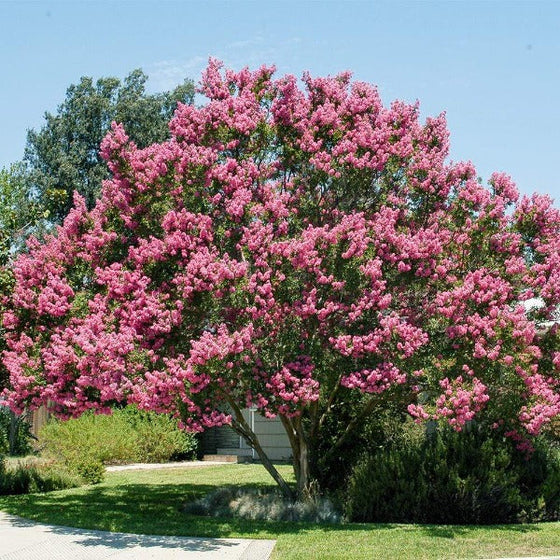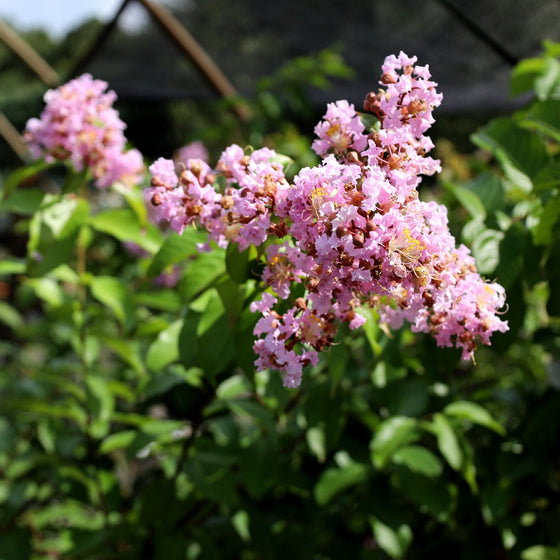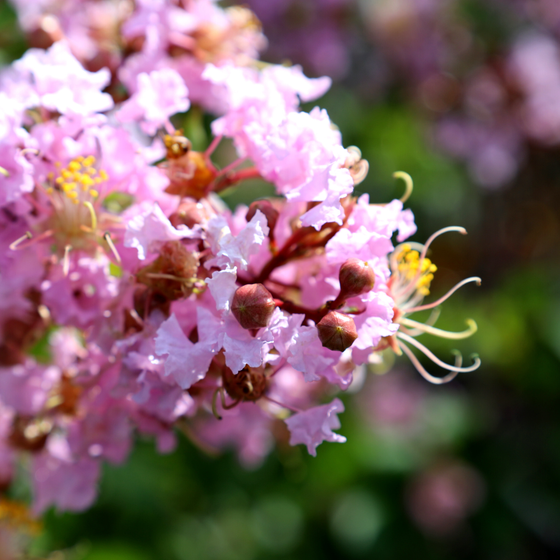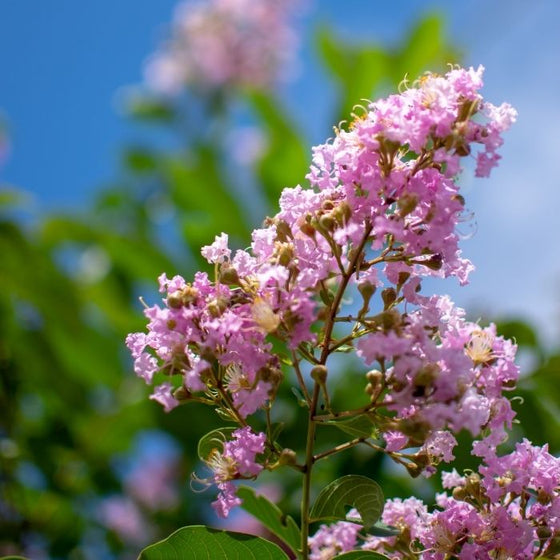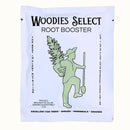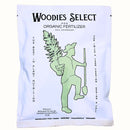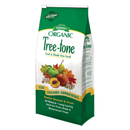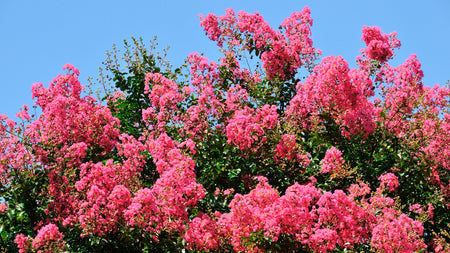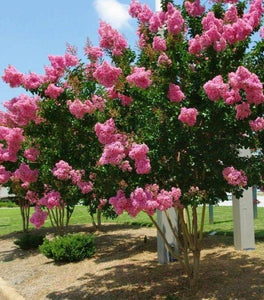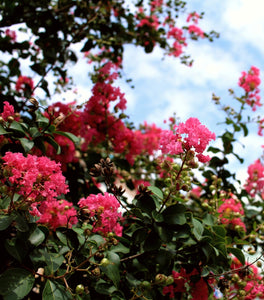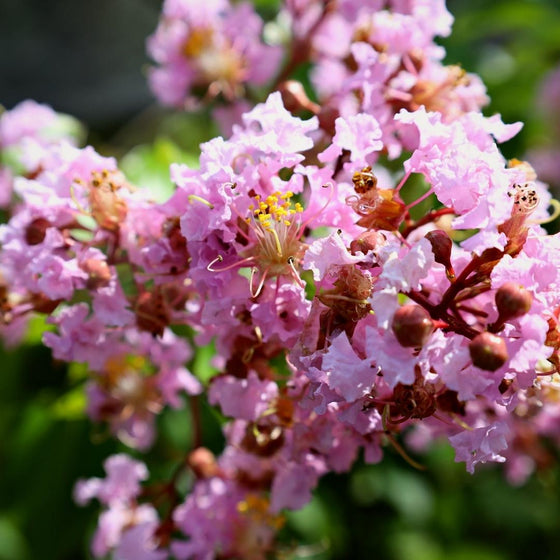
Images Depict Mature Plants
Muskogee Crape Myrtle Trees
Muskogee Crape Myrtle is a stunning, fast-growing ornamental tree celebrated for its long-lasting lavender blooms and exceptional landscape performance. Producing abundant flower clusters from mid-summer through early fall, Muskogee brings soft, elegant color to gardens and streetscapes for up to 120 days. This impressive variety grows 20 to 30 feet tall and 15 to 20 feet wide at maturity, making it ideal as a flowering shade tree, a privacy screen, or a focal point in large, sunny landscapes. Its upright, vase-like form and expansive canopy create an eye-catching silhouette throughout the year.
One of the standout features of Muskogee Crape Myrtle is its beautiful, smooth bark that exfoliates naturally to reveal rich cinnamon to light gray tones in winter. Combined with glossy green foliage that turns bronze-orange in fall, this tree provides multi-season interest beyond its spectacular summer blooms. Muskogee is also highly resistant to powdery mildew and other common diseases, offering a low-maintenance solution for gardeners seeking lasting color and structure. It thrives in full sun and well-drained soil and is drought tolerant once established, making it an excellent choice for hot, dry regions.
In addition to its visual appeal, Muskogee Crape Myrtle attracts pollinators such as bees and butterflies, enhancing biodiversity in your garden. Whether planted as a single specimen, lined along a driveway, or used in a flowering allee, Muskogee delivers reliable beauty and resilience year after year. With its vibrant lavender flowers, elegant form, and strong adaptability, Muskogee is one of the most versatile and sought-after Crape Myrtle varieties for residential and commercial landscapes alike.

| Hardiness Zone: | 6-9 |
|---|---|
| Mature Height: | 20 to 25 feet |
| Mature Width: | 15 to 20 feet |
| Classification: | Tree form |
| Sunlight: | Full sun |
| Habit: | Deciduous, densely branched, multi-stemmed summer through the first frost |
| Flower Color: | Soft lavender pink flowers in mid to late summer through the first frost |
| Foliage: | New growth emerges a rich dark green, changing to an equally vibrant orange-red in the fall |
| Soil Condition: | Any well drained soil |
| Water Requirements: | Water well until established |
| Uses: | Extremely attractive when used as a focal point in the mixed border, mass planting, or a specimen planting . Small enough for a large containers on the patio |
How to Care for Muskogee Crape Myrtle
Before you buy a Muskogee Crape Myrtle tree, make sure to read about the care instructions that are required and recommended to keep this plant healthy and thriving.
How do I plant Muskogee Crape Myrtles?
To plant your Muskogee Crape Myrtles, start by selecting a location that receives full sun for at least six hours a day, which is essential for encouraging its abundant lavender blooms. Dig a hole that is twice as wide and the same depth as the root ball, loosening the surrounding soil to promote strong root development. Place the tree in the center of the hole with the top of the root ball level with the ground. Backfill with a mixture of native soil and compost, gently tamping the soil to remove air pockets. Water thoroughly after planting, and apply a 2–3 inch layer of mulch around the base—keeping it a few inches away from the trunk—to retain moisture and suppress weeds. When planting Muskogee Crape Myrtles, be sure to provide ample space for their mature size, which typically reaches 20 to 30 feet tall and 15 to 20 feet wide. This variety is well-suited for use as a flowering specimen tree, privacy screen, or a beautiful focal point in large landscapes. For group plantings or tree-lined driveways, space trees 12 to 15 feet apart to allow for full canopy development and proper airflow. During the first growing season, water deeply and consistently to help the tree establish strong roots. With the right planting conditions and early care, your Muskogee Crape Myrtle will thrive and reward you with long-lasting blooms and multi-season landscape interest.
How do I water Muskogee Crape Myrtles?
To water your Muskogee Crape Myrtles effectively, focus on deep, thorough soakings rather than frequent, shallow watering. During the first growing season, water your tree once or twice a week, depending on weather and soil conditions, to keep the root zone consistently moist. Always water at the base of the tree to prevent fungal issues and ensure moisture reaches the roots. Deep watering encourages strong root development, which supports the tree’s long-term health, drought tolerance, and ability to produce vibrant lavender blooms. Once established, Muskogee Crape Myrtles are highly drought tolerant and typically only require supplemental watering during extended dry spells or extreme heat. A 2–3 inch layer of mulch around the base of the tree will help retain soil moisture, regulate temperature, and reduce evaporation. Before watering, check the soil 2 to 3 inches below the surface—if it feels dry, it’s time to water. Proper watering practices will keep your Muskogee Crape Myrtle healthy, lush, and blooming reliably from midsummer into fall, while also enhancing its disease resistance and overall vigor.
How do I fertilize Muskogee Crape Myrtles?
To fertilize your Muskogee Crape Myrtles, apply a balanced, slow-release fertilizer such as a 10-10-10 or 12-4-8 formula in early spring as new growth begins. Spread the fertilizer evenly around the tree’s drip line, keeping it several inches away from the trunk, and water thoroughly to help the nutrients soak into the soil. This early-season feeding supports healthy foliage, strong branching, and a long-lasting display of lavender blooms. Avoid high-nitrogen fertilizers, which may encourage excessive leaf growth at the expense of flowering. If your soil is poor or sandy, a second light application in midsummer can help sustain vigor and promote continued blooming. You can also enrich the soil naturally with organic compost or aged manure, which boosts long-term soil fertility and structure. Always follow the recommended application rates on the fertilizer label to avoid overfeeding, which can stress the plant. With the right fertilization routine, your Muskogee Crape Myrtle will flourish, delivering vibrant color, attractive bark, and reliable performance from summer through fall.

How and when should I Prune Muskogee Crape Myrtles?
You should prune your Muskogee Crape Myrtles in late winter or early spring, just before new growth begins to emerge. This is the ideal time to shape the tree and remove any dead, damaged, or crossing branches without risking the loss of flower buds, which form on new wood. Begin by thinning crowded areas within the canopy to improve airflow and light penetration, which helps reduce disease and encourages stronger blooming. Always remove suckers growing from the base and any twiggy growth that disrupts the tree’s natural vase-like structure. When pruning your Muskogee Crape Myrtle, avoid the harmful practice of “crape murder,” which involves cutting back the main trunks severely. Instead, use selective pruning to enhance the tree’s natural shape and maintain its height and form. If you wish to promote a second flush of blooms during the summer, you can lightly deadhead spent flower clusters. With proper timing and gentle pruning techniques, your Muskogee Crape Myrtle will reward you with a tall, graceful silhouette, vibrant lavender blooms, and attractive exfoliating bark that offers year-round landscape interest.

